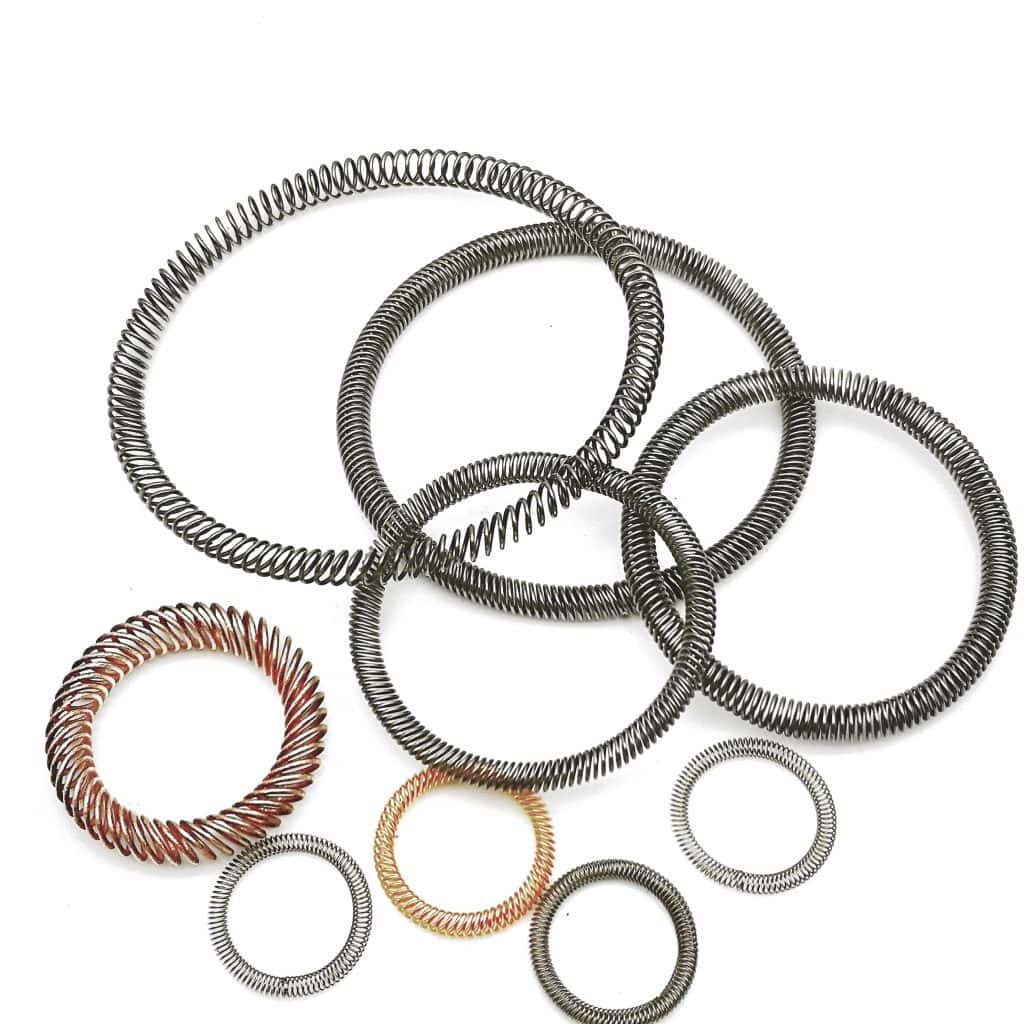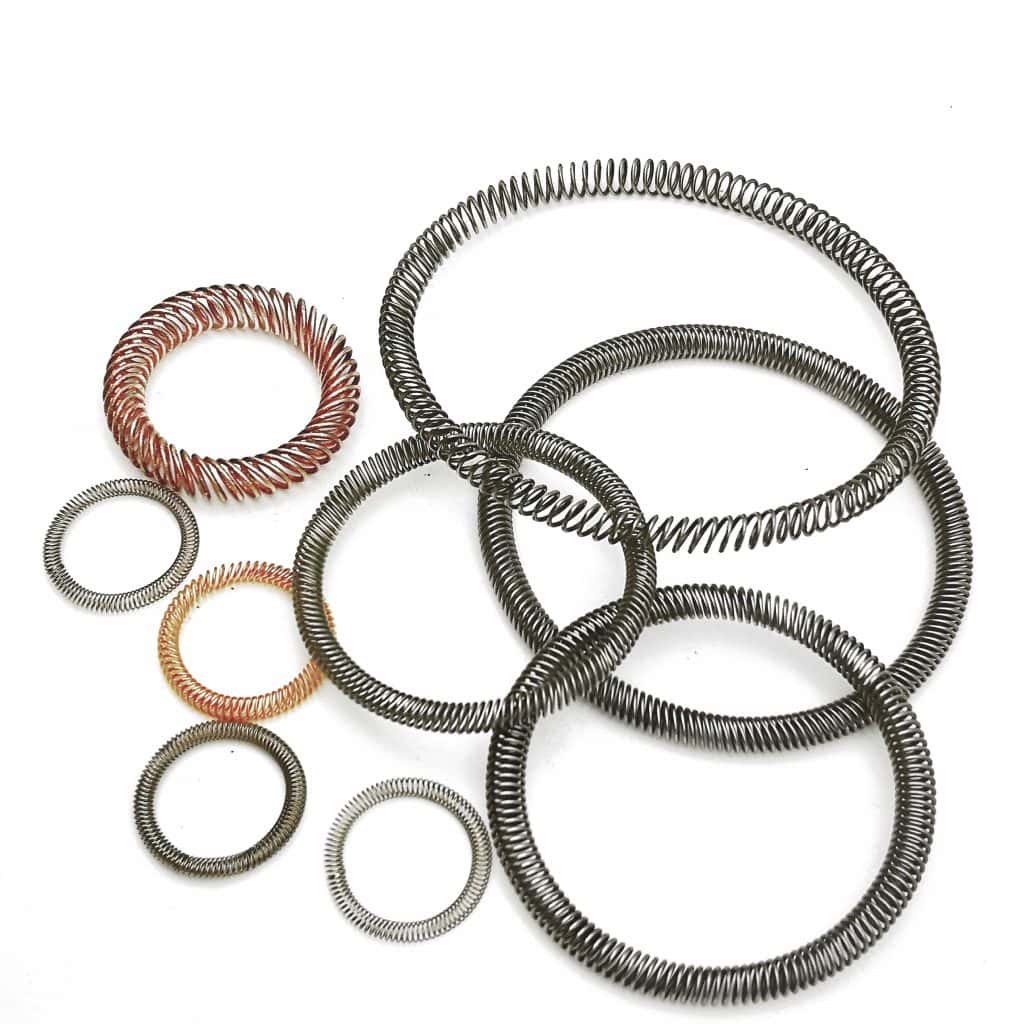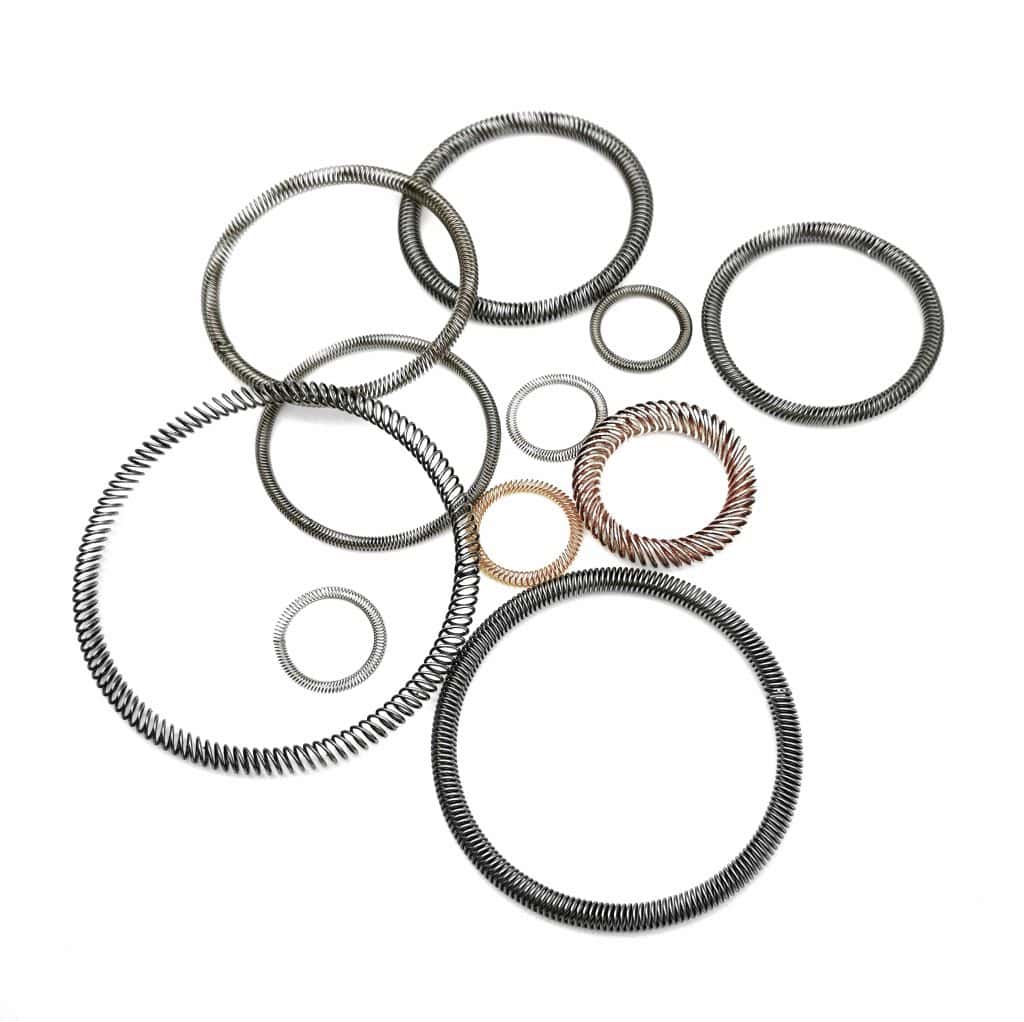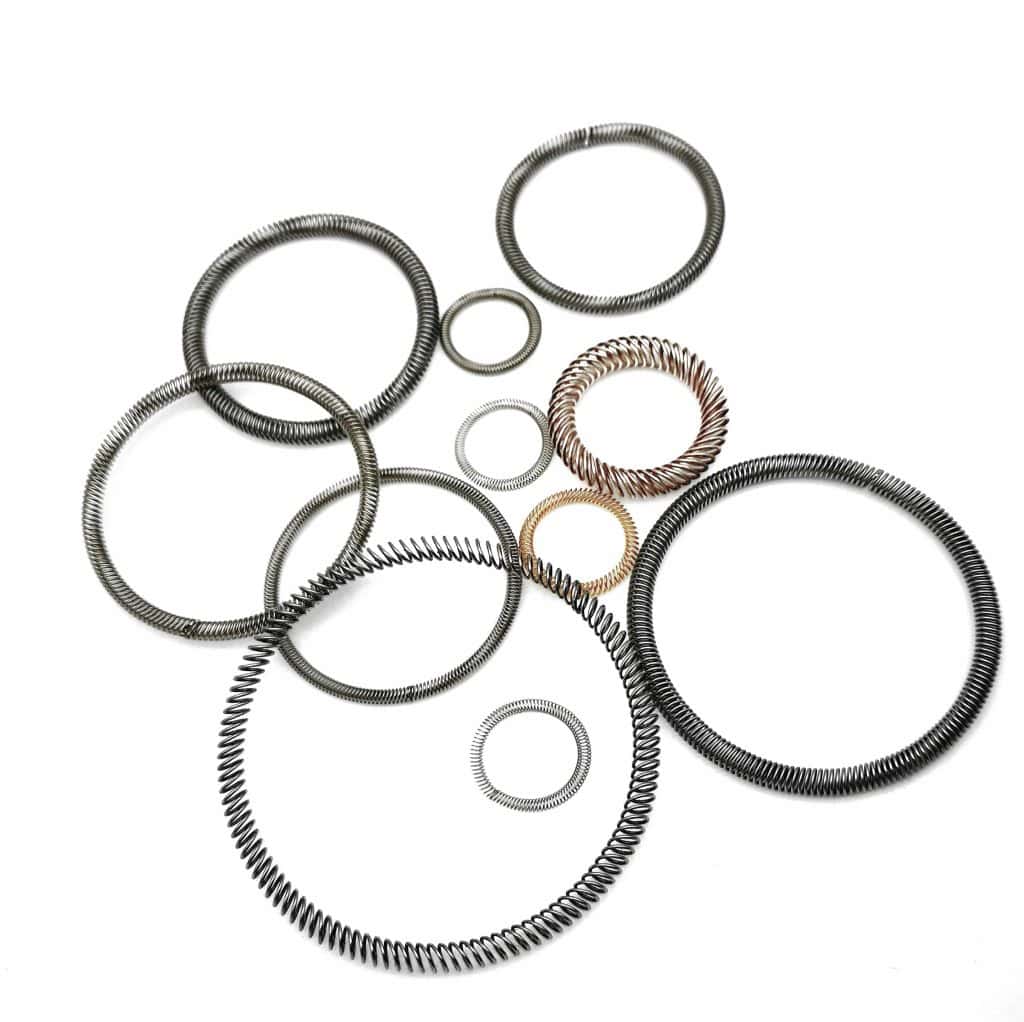An In-Depth Overview about EMI Shielding Springs
EMI shielding springs are specialized components designed to provide protection against electromagnetic interference in electronic and electrical systems. These springs play a crucial role in maintaining signal integrity and preventing unwanted noise from affecting the performance of sensitive electronic devices. This comprehensive overview will explore the design, applications, advantages, and limitations of EMI shielding springs.
Table of Contents
1. Design and Structure
1.1 Definition
EMI shielding springs(canted coil springs) are engineered to mitigate electromagnetic interference by creating conductive paths that shield electronic components from external electromagnetic fields. They can be used in various configurations, including as part of enclosures, connectors, or other shielding assemblies.

1.2 Structure
- Shape and Configuration: These EMI springs are often designed with specific geometries that optimize their performance. Common shapes include flat springs, helical springs, and custom designs tailored to fit particular applications.
- Material: Made from conductive materials such as stainless steel, copper, bronze, or specialized alloys. The material choice is crucial for ensuring effective EMI shielding and durability. Some springs may also be coated or plated with materials that enhance conductivity and resistance to environmental factors.
- Conductivity: The primary function of EMI shielding springs is to conduct electromagnetic interference away from sensitive areas. The electrical conductivity of the material is a key factor in determining the effectiveness of the shielding.
1.3 Manufacturing
The manufacturing process for EMI shielding springs involves precision engineering to create components that meet stringent performance standards. The process typically includes:
- Material Selection: Choosing conductive materials that provide the necessary shielding effectiveness.
- Forming: Shaping the material into the desired spring configuration using techniques such as stamping, coiling, or bending.
- Finishing: Applying coatings or treatments to enhance conductivity, corrosion resistance, and durability.
2. Performance Characteristics
2.1 EMI Shielding Effectiveness
EMI Shielding Springs:
- Shielding Efficiency: EMI shielding springs are designed to block or attenuate electromagnetic interference by providing a conductive path that redirects or absorbs the interference. The effectiveness of the shielding is influenced by the material’s conductivity, thickness, and the spring’s design.
- Frequency Range: Effective EMI shielding springs can provide protection across a wide frequency range, from low-frequency interference to high-frequency noise. The design and material selection play a crucial role in determining the shielding performance at different frequencies.

Traditional Shielding Methods:
- Shielding Efficiency: Conventional shielding methods, such as metal enclosures or conductive gaskets, also provide EMI protection but may not offer the same level of flexibility or ease of integration as EMI shielding springs.
- Frequency Range: The effectiveness of traditional shielding methods can vary depending on the design and material used.
2.2 Mechanical Properties
EMI Shielding Springs:
- Spring Force: EMI shielding springs are designed to provide specific mechanical forces while maintaining their shielding effectiveness. The spring force is important for ensuring proper contact and maintaining the integrity of the shielding.
- Durability: The materials used in EMI shielding springs are selected for their durability and resistance to environmental factors such as corrosion, temperature extremes, and mechanical wear.
Traditional Springs:
- Spring Force: Traditional springs used for mechanical purposes may not be optimized for EMI shielding and may lack the necessary conductivity for effective interference reduction.
- Durability: Traditional springs may not always meet the same durability requirements for EMI shielding applications.
2.3 Environmental Resistance
EMI Shielding Springs:
- Temperature Extremes: EMI shielding springs can be designed to operate effectively in a wide range of temperatures. Material selection and coatings help ensure performance under both high and low temperature conditions.
- Corrosion Resistance: Coatings or corrosion-resistant materials are often used to protect EMI shielding springs from environmental factors that could affect their performance and longevity.
Traditional Springs:
- Temperature Extremes: Traditional springs may not always perform well in extreme temperatures unless specifically designed for such conditions.
- Corrosion Resistance: The environmental resistance of traditional springs depends on the material and coatings used.

3. Applications
3.1 Electronics and Electrical Systems
EMI Shielding Springs:
- Connectors: Used in electronic connectors to maintain a conductive path between components and prevent EMI from affecting signal integrity.
- Enclosures: Integrated into enclosures to shield sensitive electronics from external electromagnetic fields and reduce interference.
Traditional Shielding Methods:
- Connectors: Conventional shielding methods include metal enclosures or conductive gaskets, but they may not offer the same flexibility or ease of integration as EMI shielding springs.
- Enclosures: Traditional shielding methods are also used in enclosures but may require more complex designs or additional components.

3.2 Automotive Industry
EMI Shielding Springs:
- Automotive Electronics: Employed in automotive electronics and communication systems to protect against EMI from the vehicle’s electrical components and external sources.
- Advantages: Provides reliable EMI protection in automotive environments where space is limited and vibration is prevalent.
Traditional Shielding Methods:
- Automotive Electronics: Conventional shielding methods are used but may not offer the same level of flexibility or ease of integration in automotive applications.

3.3 Aerospace Industry
EMI Shielding Springs:
- Avionics: Used in avionics and aerospace systems to ensure signal integrity and prevent interference in sensitive electronic equipment.
- Advantages: Provides effective EMI protection in aerospace applications where reliability and performance are critical.
Traditional Shielding Methods:
- Avionics: Conventional shielding methods are also used in avionics but may require more complex designs to achieve the same level of protection as EMI shielding springs.

3.4 Medical Devices
EMI Shielding Springs:
- Medical Equipment: Employed in medical devices to protect against EMI and ensure the proper functioning of sensitive diagnostic and therapeutic equipment.
- Advantages: Offers reliable EMI protection in medical applications where precision and reliability are essential.
Traditional Shielding Methods:
- Medical Equipment: Conventional shielding methods are used but may not provide the same level of flexibility or integration as EMI shielding springs.

4. Advantages and Disadvantages
4.1 Advantages of EMI Shielding Springs
- Effective Shielding: Provides efficient EMI shielding by creating a conductive path that reduces interference and protects sensitive electronics.
- Flexibility: Can be integrated into various designs and configurations, including connectors, enclosures, and other components.
- Durability: Made from materials that offer resistance to environmental factors such as corrosion, temperature extremes, and mechanical wear.
- Ease of Integration: Often easier to integrate into electronic assemblies compared to traditional shielding methods.
4.2 Disadvantages of EMI Shielding Springs
- Cost: May be more expensive than traditional shielding methods due to the specialized materials and manufacturing processes involved.
- Complexity: Designing and manufacturing EMI shielding springs can be more complex compared to conventional shielding solutions.

4.3 Advantages of Traditional Shielding Methods
- Cost-Effective: Generally less expensive and simpler to manufacture compared to EMI shielding springs.
- Widely Available: Traditional shielding methods, such as metal enclosures and conductive gaskets, are widely used and available.
4.4 Disadvantages of Traditional Shielding Methods
- Limited Flexibility: May not offer the same level of flexibility or ease of integration as EMI shielding springs.
- Complex Integration: Traditional shielding methods may require more complex designs or additional components to achieve the same level of protection.
5. Conclusion
EMI shielding springs provide a specialized solution for mitigating electromagnetic interference in various applications. Their design offers advantages in terms of effective shielding, flexibility, and durability. While they may be more complex and costly compared to traditional shielding methods, their benefits in terms of performance and ease of integration make them a valuable choice for protecting sensitive electronic systems.
Understanding the specific requirements of an application and the performance characteristics of EMI shielding springs can help in making informed decisions about their use. For applications where reliable EMI protection is crucial, EMI shielding springs offer distinct advantages that can enhance overall system functionality and performance.